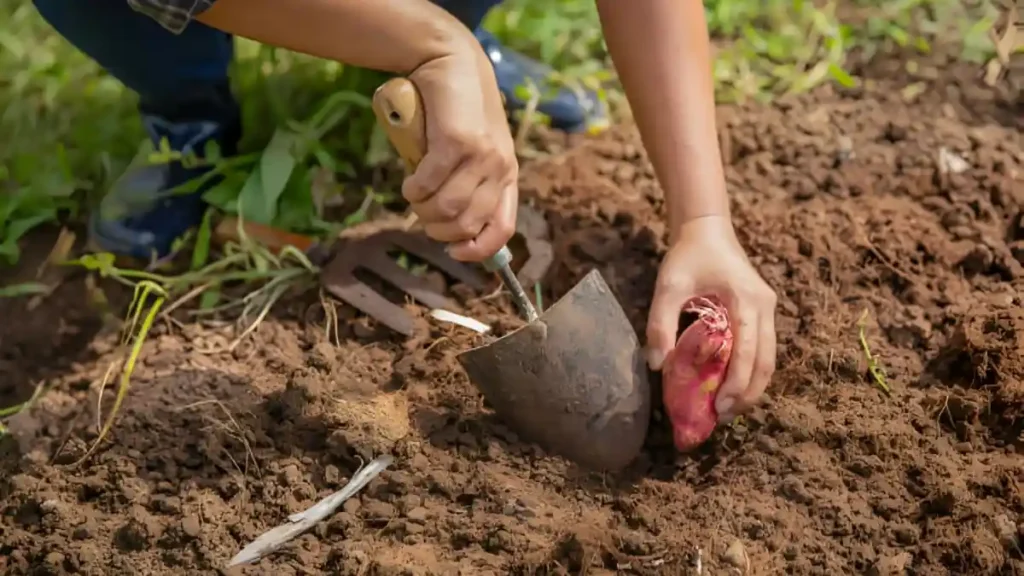Growing sweet potatoes in your yard may be quite satisfying, in addition to being a tasty addition to any meal. It can be rewarding and helpful to learn how to grow sweet potatoes quickly, regardless of experience level in gardening. You may quickly reap the benefits of a plentiful harvest of these nutrient-dense tubers if you have the appropriate knowledge and skills.
Here’s a guide to show you how to grow sweet potatoes quickly:
Selecting the appropriate sweet potato types:
- Pick sweet potatoes that are renowned for growing quickly. Beauregard, Georgia Jet, and Vardaman are good to choose from since they mature faster than other cultivars.
Make use of high-quality slips:
- Typically, “slips,” or sprouts developed from a mature sweet potato, are used to grow sweet potatoes. To give your plants a head start, make sure you start with healthy slips from a reliable supplier.
Give enough sunlight:
- For optimum growth, sweet potatoes need full light. In your garden, pick a spot that gets at least 6 to 8 hours of direct sunlight each day.
Get the soil well-drained:
- Sweet potatoes like rich, well-draining soil. To guarantee that the soil is rich in nutrients and has good drainage, work with a lot of compost.
How to grow sweet potatoes using plant slips at the proper time:
- Once the risk of frost has passed and the soil has warmed to at least 55°F (13°C), plant your sweet potato slips in the spring. Faster growth is encouraged by warmer soil temperatures.
Plants in the right spot:
- Plant slips in rows three feet apart, spaced roughly 12 to 18 inches apart. Enough room between plants promotes healthy air circulation and better nutrient and water uptake by each one.

Regular watering:
- Watering regularly is essential, particularly in the early phases of growth. Ensure that the soil is continually moist and give the plants plenty of water.
Apply fertilizer correctly:
- Since sweet potatoes are moderate eaters, frequent fertilizing is beneficial. Before planting, apply a balanced fertilizer (such as 10-10-10), and during the growing season, side-dress with compost or a fertilizer that is high in nitrogen.
How to grow sweet potatoes while managing weeds and space:
- To retain soil moisture, control weed growth, and adjust soil temperature, surround the plants with a layer of organic mulch, such as straw or crushed leaves. Giving the roots a more solid environment also promotes faster growth.
Observe for diseases and pests:
- Check out for common illnesses and pests. The key to managing them is early discovery and natural control techniques.
Harvest timely:
- 90–120 days after planting, sweet potatoes are usually available for harvesting, depending on the cultivar and growing circumstances. Harvesting shouldn’t happen until the foliage starts to turn yellow and die back. To guarantee that the tubers are stored properly, take care not to harm them during harvest.

Sweet potatoes are cold sensitive, therefore they require care during the winter. If you live in a cold climate, pick them before the first frost, cure them in a warm, humid environment for approximately 10 days, and store them in a cool, dry location. If grown indoors, keep slips in a warm location with lots of light. Mulching outdoor beds might help insulate any roots that overwinter in moderate areas.
Conclusion:
How to grow sweet potatoes quickly requires proper growing conditions. This entails choosing the sweet potato variety that is best for your soil and climate, making sure they get enough sunlight, and giving them soil that drains well and is rich in organic matter. Furthermore, consistent fertilization and watering can encourage quick development. You can have a plentiful harvest of sweet potatoes in a comparatively short amount of time with the right care and attention.
Certainly! If you’d like to learn more, please consider following our WhatsApp Channel, Facebook, Instagram, YouTube, Twitter, and Pinterest.
A frequently asked questions:
Q1: What kind of soil do I need to grow sweet potatoes?
A1: Sweet potatoes thrive in well-draining, pH 5.8-6.2 sand loam soil, but struggle in clay-heavy soils. Composting can improve soil texture and fertility.
Q2: Can I grow sweet potatoes in containers?
A2: Yes, sweet potatoes can be grown in containers; however, they must have adequate drainage and be big enough to fit the vines.
Q3: How to grow sweet potatoes in containers?
A3: Sweet potato slips should be planted in a large container with well-draining soil, and the container should receive regular sunlight and watering.
Q4: How long does it take to grow sweet potatoes?
A4: From planting to harvest, sweet potatoes normally take three to four months to mature.
Q5: Can I grow sweet potatoes from a sweet potato?
A5: Yes, sweet potatoes may be grown from a sweet potato by sprouting “slips.” Cut a sweet potato in half, set it in water or soil, and when the sprouts appear, remove and plant them in the ground.



